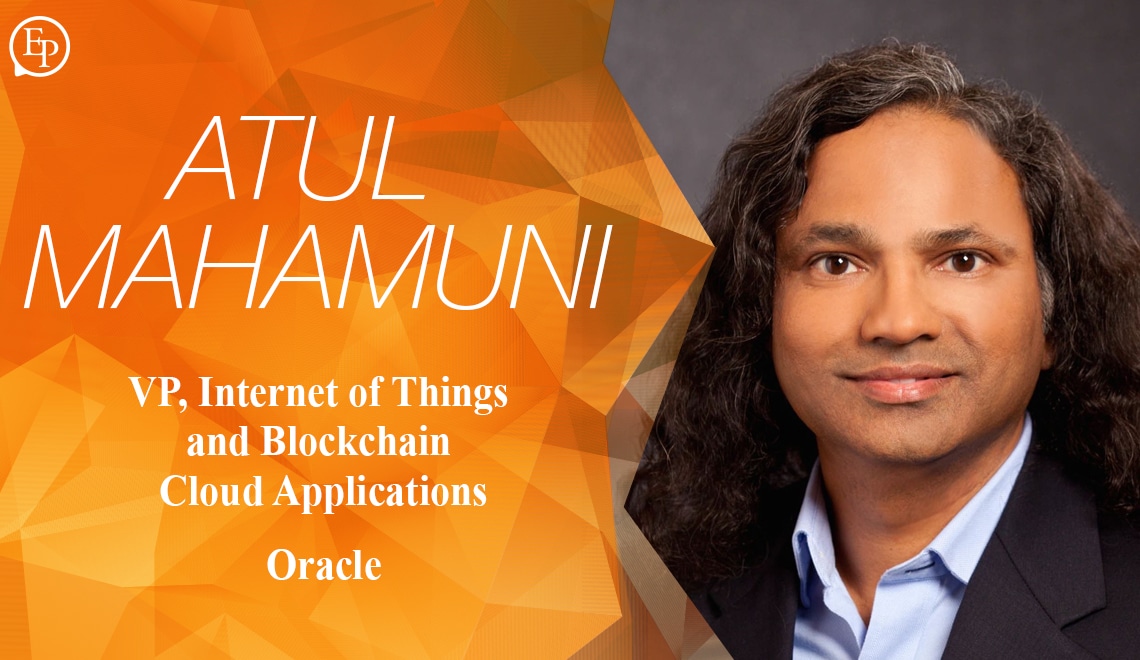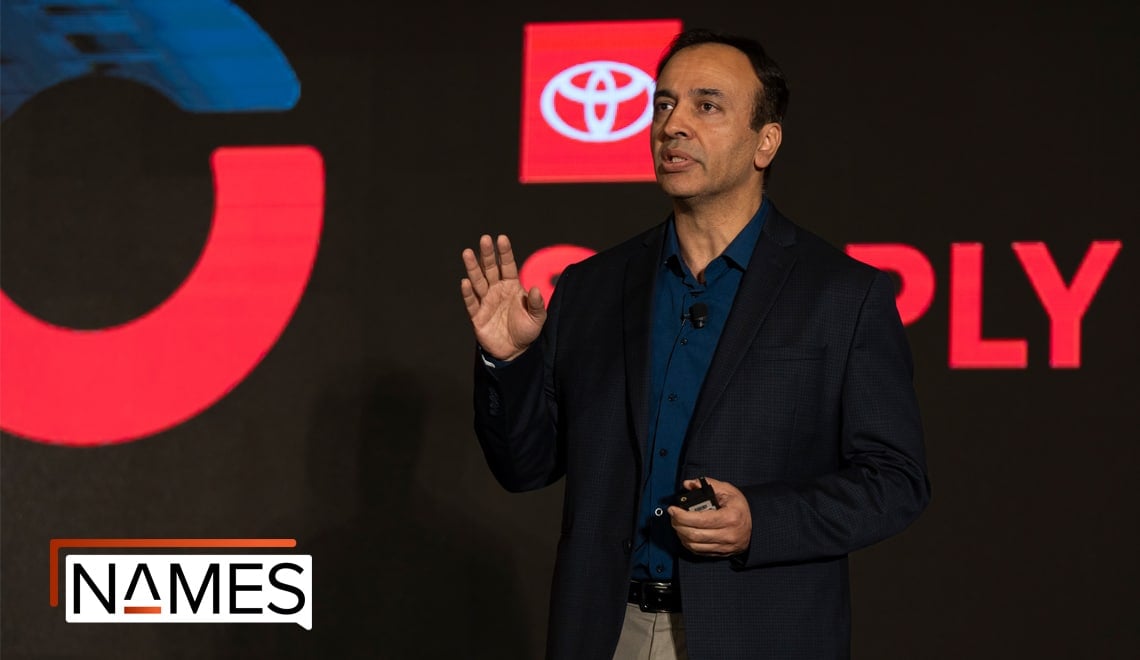As part of the 2018 edition of the North American Manufacturing Excellence Summit, Atul Mahamuni, Oracle’s VP, Internet of Things and Blockchain Cloud Applications, gave an in-depth interview on how manufacturers are embracing Industry 4.0 solutions with specific examples and lessons learned to illustrate what all successful rollouts of these new tools have in common.
The full transcript of the interview is below, or you can download a PDF version.
What is the real competitive advantage of the Industrial Internet of Things for the early adaptors, the companies that are well-launched into their journey?
First of all, the benefits of Industry 4.0 are all about productivity gains, about understanding our processes, about achieving our productivity goals through the reduction of unpredictability. Reducing things like unplanned downtime and increasing continuous production.
I would also say people have been talking about Industry 4.0 for a while now, so I think your question could also be, “Why are there so few companies that have successfully done something?”
I think that speaks to a void in the market that is impacting early adaptors.
Most vendors today are offering IIoT platforms, and there is a gap between the platform and what you need to build on top of an IIoT platform before you see a solution that delivers results. Early adaptors have had to take the risk of investing in a platform and building their solutions on top of it, and that’s what the early adaptors have done that their competition has not done.
What we try to do at Oracle is reduce that risk. It shouldn’t take a lot of time and money to create a custom solution. We believe it’s our job in the vendor community to create applications and solutions that our customers can deploy very quickly so they can see the ROI very quickly.
In a lot of conversations when we talk about new tools, new processes, at the end of the day it really comes down to people. Tell us a little bit about the people part of how manufactures are moving into Industry 4.0.
You cannot talk about moving into Industry 4.0 without talking about the people involved in that journey. There are two things that happen as we bring in new tools. We have people in the workforce doing the mundane job of data collection, and we also have people spending time on mid-level data analysis and operations research. Those things do not need to be done manually in an IIoT environment anymore with the help of machine learning and artificial intelligence, and that can lead to a little bit of resistance because we are changing the way people spend their time.
With that said, that initial friction quickly disappears, because we are actually helping people do their jobs better. Taking those boring jobs out of their hands and doing those better through automation very quickly demonstrates its value to the workforce: It helps them avoid the costly, stressful breakdowns that lead to high-stress environments that are created when a machine failure takes a production line offline.
Can you give us an example of what you are talking about?
We are working with a steel manufacturer right now. Their problem is they are building large steel sheets, and they explained to us that when something goes wrong in their manufacturing process, the sheets will jam in the machinery exactly the same way pages jam inside a printer, except imagine it is happening to a very large sheet of steel, right?
It is a major breakdown of productivity for them. They have to shut the whole line down, take heavy machinery apart, get the jammed steel out, and sometimes those sheets end up as scrap. It is a real mess, and this sort of thing impacts everyone.
With Industry 4.0 solutions, we are spotting the problems in the equipment and the processes earlier and more accurately than was possible before. We are able to anticipate where and when a breakdown will happen so the steel sheets can be corrected before the unplanned downtime. It really is benefiting people in the long-term, so once you get past that initial friction, that hesitation that their job is changing, they become very happy to see how the new tools are helping them to do their jobs better.
That’s when the culture starts changing.
When we talk about rollouts of these technologies, obviously Industry 4.0 is a new day, but can you start small and scale up, or is it always sort of a company wide initiative? How do you launch something like this from the beginning?
Great question. So often when people talk about Industry 4.0, they’re talking about enormous trends like switching from Reactive to Proactive Maintenance at a very large scale, and that seems too big to imagine. Very few companies go from nothing to everything in a single jump. I have been working on IIoT projects for ten years now, including many very large projects throughout North America. In my experience people most often launch Industry 4.0 in a three-step process, in three distinct steps.
Step number one is about getting visibility. Many times because machines are not connected, because people are not connected, because facilities are not connected, you can almost imagine it as a blindfolded man walking a tightrope: He is going to feel pretty good just not falling off. That is his only productivity goal. Do not ask him to do better than that. He cannot see everything that is happening around him. He can have a sense of things, of course, but without complete data, he cannot do better.
So what does taking the blindfold off mean? How do we gain visibility? Well, let’s start connecting things. Let’s get data collection going. Let’s get dashboards out of the box and have something in front of you that screams loudly when something goes wrong. One of the things that I really embrace is the idea that, “If you can’t monitor it, you can’t manage it.” If people don’t have good access to the flow of real-time information happening around them, how are they going to improve their operations? Getting that visibility based on real-time accurate information is step number one, always.
Step number two is about having the ability to take action on the data. You have visibility, you have all this information you could want. What are you going to do with it? Well, as I mentioned with the example of the steel sheet manufacturer earlier, accurate information at the right time can allow you to act right then and there to respond before something becomes a problem.
Almost always, that is the lightbulb moment culturally within a workforce. The number of times a reoccurring problem could have been avoided if it had been foreseen even two hours earlier, and now with an Industry 4.0 solution you do have that head’s up, you do have that early warning. In fact, usually it is more than two hours earlier. It can be eight hours earlier. It can be a whole shift ahead of time, and you can plan your day around the issue that needs to be addressed without any unplanned downtime. I call this the predictive insight step, because you have moved from reactive to proactive planning in that time.
Step number three comes after you have had some experience in that transformation of workflow. You are now going to be able to operate with multidimensional data. You are not just looking at one process, or at one facet of your business. You are looking at your supplier data, at your operator data, at your ERP, at your plant floor, at your financial operations. Blending all that data gives you the ability to do things you could never do before.
I like to talk about the Five Ms of efficiency that were first defined in Japan years ago during the last Industrial Revolution: We can talk about the Manpower, the Materials, the Methods, the Machines, and the Management. Now the information coming in from the machine through IIoT is a new thing, but you also need to learn who is the operator on that machine. You need to know the machine’s operating parameters. You need to know about your suppliers. What materials have gone into that lot of production? Building all of this data together –not just the machine data, but the operational data of your processes from end to end—that is where you start really seeing what Industry 4.0 can really do for you.
Those three steps: First, connecting the assets and getting visibility, second, getting smart about it and build analytics and machine learning that can make actionable predictions, and third transforming the way you understand your business, that is how you make Industry 4.0 work. That is why I think people should view these Industry 4.0 solutions less as a product and more as a journey.
That was a lot of information. Can you illustrate these steps with a specific example?
Absolutely. One of my customers is a chemical valve manufacturer in Germany whose customers are typically pharmaceutical companies. You need to understand that various chemicals come into contact with these valves, and they deteriorate at very different rates. Some valves operate perfectly for years, and others might go bad in a few hours. When a valve does go bad, it can be very hard to spot that something is wrong before the quality of the manufacturing process that valve is a part of is compromised.
So the valve manufacturer came to us and said, “Can you help our customers figure out when our valves will fail and set up an automatic shutdown to stop the process right then and there?”
It makes a lot of sense. I mean, if you can imagine a valve fails, and that is not discovered until a quality control check of the product at the end of the manufacturing process, everything manufactured while that valve was broken is compromised, and needs to be scrapped.
Setting up an automated check to see if the valve is opening and closing correctly and turning off the process if the has failed is step one, which is gaining visibility. We can see it, we have the data about its operations, it is connected to our control systems. That is good, but that is just a beginning of the journey.
Let’s talk about step two. They say to me, “Hey, it’s good that we switch off the process when a valve fails, but if you can tell me two hours before a valve fails which one is going to fail, I would swap it out before it impacts my manufacturing process at all.”
No problem. Looking at the data we had available to us –the type of valve, the type of chemicals it is in contact with, how long the valve has been in use, how long that type of valve lasts under those conditions based on existing historically data— put all this into an AI system, and we can very easily build a proactive maintenance program so that the manufacturing process never needs to be shut down, even though we still have the automated safeguard system in place just in case. We have now moved into a predictive insight state: Workers at the start of their shift replace the valves they are told to replace by our analytics before they start their manufacturing processes, and now they can run the rest of the shift without interruption.
Now we are on to the third step. We know when the valves need to be replaced before they fail, and that is part of the start-up procedures for that manufacturing process. Let’s talk about the operators running the machines. How are they doing their jobs? What more can they do now that they are not constantly on call to replace failed valves? What about the supply of raw materials coming into that manufacturing process? What happens to the product after it leaves this stage of the manufacturing process? Can we improve throughput? Where are the opportunities to improve things based on the data we now have in our system?
We came into the process because valves do not last forever, and we ended up making pharmaceuticals more efficiently through IIoT and AI tied together in an Industry 4.0 solution.
Let’s talk about Oracle specifically for a moment. How has Oracle built and maintained its leadership position in Industry 4.0 solutions relevant to manufacturers?
Oracle has focused on business outcomes. We believe that if we deliver business outcomes to our customers, a lot of other things become better and easier along the way, which helps them do their jobs more efficiently.
During the discovery phase, we always ask the customers, “What is the gap in what you are trying to achieve?” Two major things emerge: One, I think people find the problem of creating the best supply chain or manufacturing solution, mentoring colleagues to use the new tool effectively, it is challenging — and two, connecting it back to the physical world. That IIoT gap between the plan and the reality is what a lot of people talk about. So what kind of things can be done done to really extend the IIoT systems, the manufacturing systems, the supply chain systems into the physical world? We don’t start these discussions with what sensors the customers need to connect. We start with the business outcomes and we keep our focus on these outcomes throughout the IIOT deployment process. That’s the kind of approach that we think separates Oracle from the competition.
Can you illustrate that point with an example?
If you have a customer buying a transportation solution or a manufacturing solution, we ask them, “How is your data fed into these systems?” Almost always the answer is manually, and when you have manual data entry you run into several problems: That data is not accurate; the data is not complete; sometimes important data is not recorded; sometimes there is some subjectivity around it; there are errors in it. A data-driven solution is only as good as its data, and so the best-designed solution in the world is not going to work when there is a gap between the plan and the reality of how the plan receives data.
When you close the gap between the plan and the physical world, you are connecting your physical systems –your shop floor, your transportation fleet– directly into your business applications. That keeps the data complete and accurate, you will get a much higher level of productivity built upon fewer errors. By doing so, we do a couple of other things: One, we can create real-time dashboards built upon the real KPIs of your processes, so instantly that adds value to the application. The second thing we do is, now that you have the data, we can predict things. Understanding how things work allows us to give you a peek in the future and inform you of some impending problems before they occur, so you have time to react to that and fix them before something goes wrong, which speaks to the ultimate goal of zero unplanned downtime.
Things should just work. They should not fail unpredictably. We work from the data to build reliability and consistency. That is what our solutions are designed to do.
What is the key take away or the piece that you really want people to think about when they think about moving into IIoT or into Industry 4.0? What is important that they understand?
Well, there are a couple of things. First, think of steps. Start small. Have a big dream, but start with small steps because otherwise you’re going to get disappointed that you didn’t get the big ROI right from the beginning.
Second, look at Industry 4.0 solutions with your business outcome in mind. What are you trying to do? If you say, “I want to reduce unplanned downtime 20% in my first year into this program and 40% the year after that,” then you can go look for a vendor who can help you achieve a very concrete and measurable goal. There are a lot of companies who can help you connect assets to the IIoT or give you a platform for you to build things on. You should be doing business with someone who understands your business outcomes and can show you how to achieve those goals. That lets you remain focused on what is important to you.
Third, think about the data and the predictions that you actually need to achieve the outcomes that you outlined. What are the missing insights keeping you from achieving your business outcome? After you have identified the needed insights, figure out what data you need to collect from your physical systems to deliver those insights to you. This approach delivers successful outcomes than the traditional approach taken by most companies of simply using an IIoT platform to connect sensors and collect data. If all you want is data, there is so much data out there to find. Right now, less than one 1% of the data manufacturers collect is actually being used for a useful purpose. If you don’t start with the business outcome in mind, if you’re collecting data just because you can, you are not going to achieve anything.
Stay focused on your goal, know what you need, and we are now in a position to get you there.
—
Atul Mahamuni
VP, Internet of Things and Blockchain Cloud Applications
Oracle

Prior to joining Oracle, Atul worked for Cisco as Vice President, Engineering – IoT Group. Previously, he was CTO for Cisco’s Catalyst 3xxx line of Ethernet switches.
Atul holds a master’s degree from Indian Institute of Technology (IIT) Chennai India, and has 24 issued patents.

















